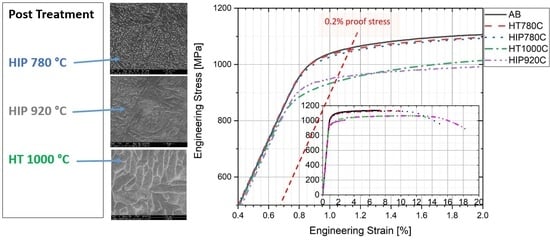Tailoring Microstructure and Mechanical Properties of Additively-Manufactured Ti6Al4V Using Post Processing
Abstract
:1. Introduction
2. Experimental
2.1. Sample Preparation
2.2. Sample Characterization
3. Results
3.1. Density
3.2. Phase Evolution with Temperature
3.3. Microstructure
3.4. Tensile Properties
3.5. Fatigue
4. Discussion
5. Summary and Conclusions
- It is possible to modify the combination of fatigue strength and other mechanical properties of AM Ti64, through changing HIP parameters.
- HIP at 920 °C changes the fine AM microstructure due to grain growth that causes a decrease of the yield stress, YS, (976 MPa) and the UTS (1090 MPa), while HIP at 780 °C retains the fine microstructure and the high YS and UTS of the as-built samples (1038 MPa and 1135 MPa, respectively).
- HIP improved the ductility and fatigue life due to the elimination of pores, lack of fusion and overheating flaws. HIP at 780 °C leads to nearly fully dense samples.
- The density of HIP 780 °C vs. HIP 920 °C was identical (within measurement error), while the β phase content increased from ~1% at 780 °C to ~3% at HIP 920 °C. Thus, differences between the two HIP processes can be attributed to the changes in microstructure and β phase content and not to density.
- HIP at lower temperature led to a small scatter of the mechanical properties due to finer microstructure. Therefore, it would be recommended, in certain applications, to use lower temperatures than the current ASTM standard specifies.
- Heat treatment at 1000 °C is a promising post-treatment although it alters the microstructure, and results in a β content of ~7%, the mechanical properties; elongation, 13.7%, the YS, 927 MPa and UTS, 1063 MPa, surpass the ASTM F2924 minimum requirements. However, fatigue testing is recommended (if applicable).
- In a future study, a model for optimizing mechanical properties and selected parameters using optimization tools and a backing mathematical model can be used in order to attain better results.
Author Contributions
Funding
Institutional Review Board Statement
Informed Consent Statement
Data Availability Statement
Acknowledgments
Conflicts of Interest
References
- Schauerte, O. Titanium in Automotive Production. Adv. Eng. Mater. 2003, 5, 411–418. [Google Scholar] [CrossRef]
- Fujii, H.; Takahashi, K.; Yamashita, Y. Application of Titanium and Its Alloys for Automobile Parts; EDP Sciences: Les Ulis, France, 2003. [Google Scholar]
- Liu, S.; Shin, Y.C. Additive manufacturing of Ti6Al4V alloy: A review. Mater. Des. 2019, 164, 107552. [Google Scholar] [CrossRef]
- Tiferet, E.; Ganor, M.; Zolotaryov, D.; Garkun, A.; Hadjadj, A.; Chonin, M.; Yeheskel, O. Mapping the Tray of Electron Beam Melting of Ti-6Al-4V: Properties and Microstructure. Materials 2019, 12, 1470. [Google Scholar] [CrossRef] [PubMed] [Green Version]
- Zhang, L.-C.; Liu, Y.; Li, S.; Hao, Y. Additive Manufacturing of Titanium Alloys by Electron Beam Melting: A Review. Adv. Eng. Mater. 2018, 20, 1700842. [Google Scholar] [CrossRef]
- Körner, C. Additive manufacturing of metallic components by selective electron beam melting—A review. Int. Mater. Rev. 2016. [Google Scholar] [CrossRef] [Green Version]
- Murr, L.E.; Gaytan, S.M.; Ramirez, D.A.; Martinez, E.; Hernandez, J.; Amato, K.N.; Wicker, R.B. Metal Fabrication by Additive Manufacturing Using Laser and Electron Beam Melting Technologies. J. Mater. Sci. Technol. 2012, 28, 1–14. [Google Scholar] [CrossRef]
- Svensson, M.; Ackelid, U.; Ab, A. Titanium alloys manufactured with electron beam melting mechanical and chemical properties. In Proceedings of the Materials and Processes for Medical Devices Conference, Minneapolis, MN, USA, 10–12 August 2019; ASM International: Almere, The Netherlands, 2010. [Google Scholar]
- Rafi, H.K.; Karthik, N.V.; Gong, H.; Starr, T.L.; Stucker, B.E. Microstructures and Mechanical Properties of Ti6Al4V Parts Fabricated by Selective Laser Melting and Electron Beam Melting. J. Mater. Eng. Perform. 2013, 22, 3872–3883. [Google Scholar] [CrossRef]
- De Formanoir, C.; Michotte, S.; Rigo, O.; Germain, L.; Godet, S. Electron beam melted Ti6Al4V: Microstructure, texture and mechanical behavior of the as-built and heat-treated material. Mater. Sci. Eng. A 2016, 652, 105–119. [Google Scholar] [CrossRef]
- Hrabe, N.; Quinn, T. Effects of processing on microstructure and mechanical properties of a titanium alloy (Ti6Al4V) fabricated using electron beam melting (EBM), Part 2: Energy input, orientation, and location. Mater. Sci. Eng. A 2013, 573, 271–277. [Google Scholar] [CrossRef]
- Al-Bermani, S.S.; Blackmore, M.L.; Zhang, W.; Todd, I. The Origin of Microstructural Diversity, Texture, and Mechanical Properties in Electron Beam Melted Ti6Al4V. Metall. Mater. Trans. A 2010, 41, 3422–3434. [Google Scholar] [CrossRef]
- Galarraga, H.; Warren, R.J.; Lados, D.A.; Dehoff, R.R.; Kirka, M.M.; Nandwana, P. Effects of heat treatments on microstructure and properties of Ti6Al4V ELI alloy fabricated by electron beam melting (EBM). Mater. Sci. Eng. A 2017, 685, 417–428. [Google Scholar] [CrossRef] [Green Version]
- Vrancken, B.; Thijs, L.; Kruth, J.-P.; Van Humbeeck, J. Heat treatment of Ti6Al4V produced by Selective Laser Melting: Microstructure and mechanical properties. J. Alloys Compd. 2012, 541, 177–185. [Google Scholar] [CrossRef] [Green Version]
- Thijs, L.; Verhaeghe, F.; Craeghs, T.; Humbeeck, J.; Van Kruth, J.-P. A study of the microstructural evolution during selective laser melting of Ti6Al4V. Acta Mater. 2010, 58, 3303–3312. [Google Scholar] [CrossRef]
- Shui, X.; Yamanaka, K.; Mori, M.; Nagata, Y.; Kurita, K.; Chiba, A. Effects of post-processing on cyclic fatigue response of a titanium alloy additively manufactured by electron beam melting. Mater. Sci. Eng. A 2017, 680, 239–248. [Google Scholar] [CrossRef]
- Qian, M.; Xu, W.; Brandt, M.; Tang, H.P. Additive manufacturing and postprocessing of Ti6Al4V for superior mechanical properties. MRS Bull. 2016, 41, 775–784. [Google Scholar] [CrossRef] [Green Version]
- Xu, W.; Lui, E.W.; Pateras, A.; Qian, M.; Brandt, M. In situ tailoring microstructure in additively manufactured Ti6Al4V for superior mechanical performance. Acta Mater. 2017, 125, 390–400. [Google Scholar] [CrossRef]
- Qazi, J.I.; Rahim, J.; Fores, F.H.; Senkov, O.N.; Genc, A. Phase transformations in Ti6Al4V-xH alloys. Metall. Mater. Trans. A 2001, 32, 2453–2463. [Google Scholar] [CrossRef]
- Sieniawski, J.; Ziaja, W.; Kubiak, K.; Motyka, M. Microstructure and Mechanical Properties of High Strength Two-Phase Titanium Alloys. Titan. Alloys Adv. Prop. Control 2013. [Google Scholar] [CrossRef] [Green Version]
- Donachie, M.J. Titanium: A Technical Guide; ASM International: Almere, The Netherlands, 2000. [Google Scholar]
- Ter Haar, G.M.; Becker, T.H. Selective Laser Melting Produced Ti6Al4V: Post-Process Heat Treatments to Achieve Superior Tensile Properties. Materials 2018, 11, 146. [Google Scholar] [CrossRef] [Green Version]
- Tammas-Williams, S.; Withers, P.J.; Todd, I.; Prangnell, P.B. The Influence of Porosity on Fatigue Crack Initiation in Additively Manufactured Titanium Components. Sci. Rep. 2017, 7, 7308. [Google Scholar] [CrossRef]
- Chastand, V.; Tezenas, A.; Cadoret, Y.; Quaegebeur, P.; Maia, W.; Charkaluk, E. Fatigue characterization of Titanium Ti6Al4V samples produced by Additive Manufacturing. Procedia Struct. Integr. 2016, 2, 3168–3176. [Google Scholar] [CrossRef] [Green Version]
- Hrabe, N.; Gnäupel-Herold, T.; Quinn, T. Fatigue properties of a titanium alloy (Ti6Al4V) fabricated via electron beam melting (EBM): Effects of internal defects and residual stress. Int. J. Fatigue 2017, 94, 202–210. [Google Scholar] [CrossRef] [Green Version]
- Atkinson, H.V.; Davies, S. Fundamental aspects of hot isostatic pressing: An overview. Metall. Mater. Trans. A 2000, 31, 2981–3000. [Google Scholar] [CrossRef]
- Strumza, E.; Hayun, S.; Barzilai, S.; Finkelstein, Y.; David, R.B.; Yeheskel, O. In situ detection of thermally induced porosity in additively manufactured and sintered objects. J. Mater. Sci. 2019, 54, 8665–8674. [Google Scholar] [CrossRef]
- Tammas-Williams, S.; Withers, P.J.; Todd, I.; Prangnell, P.B. Porosity regrowth during heat treatment of hot isostatically pressed additively manufactured titanium components. Scr. Mater. 2016, 122, 72–76. [Google Scholar] [CrossRef]
- Eylon, D.; Schwenker, S.W.; Froes, F.H. Thermally induced porosity in Ti6Al4V prealloyed powder compacts. Metall. Trans. A 1985, 16, 1526–1531. [Google Scholar] [CrossRef]
- German, R.M. Sintering Theory and Practice; Wiley: Hoboken, NJ, USA, 1996; p. 568. [Google Scholar]
- Helle, A.S.; Easterling, K.E.; Ashby, M.F. Hot-isostatic pressing diagrams: New developments. Acta Metall. 1985, 33, 2163–2174. [Google Scholar] [CrossRef]
- Hazzledine, P.M.; Schneibel, J.H. Theory of coble creep for irregular grain structures. Acta Metall. Mater. 1993, 41, 1253–1262. [Google Scholar] [CrossRef]
- Coble, R.L. A Model for Boundary Diffusion Controlled Creep in Polycrystalline Materials. J. Appl. Phys. 1963, 34, 1679–1682. [Google Scholar] [CrossRef]
- Voisin, T.; Calta, N.P.; Khairallah, S.A.; Forien, J.B.; Balogh, L.; Cunningham, R.W.; Wang, Y.M. Defects-dictated tensile properties of selective laser melted Ti6Al4V. Mater. Des. 2018, 158, 113–126. [Google Scholar] [CrossRef]
- ASTM International. ASTM E8M: Standard Test Methods for Tension Testing of Metallic Materials; ASTM International: West Conshohocken, PA, USA, 2016. [Google Scholar]
- ASTM International. ASTM E466: Standard Practice for Conducting Force Controlled Constant Amplitude Axial Fatigue Tests of Metallic Materials; ASTM International: West Conshohocken, PA, USA, 2015. [Google Scholar]
- ASTM International. ASTM E606: Standard Test Method for Strain-Controlled Fatigue Testing; ASTM International: West Conshohocken, PA, USA, 2019. [Google Scholar]
- Sol, T.; Hayun, S.; Noiman, D.; Tiferet, E.; Yeheskel, O.; Tevet, O. Nondestructive ultrasonic evaluation of additively manufactured AlSi10Mg samples. Addit. Manuf. 2018. [Google Scholar] [CrossRef]
- Yeheskel, O.; Dariel, M.P. The effect of processing on the elastic moduli of porous γ-TiAl. Mater. Sci. Eng. A 2003, 354, 344–350. [Google Scholar] [CrossRef]
- Pesach, A.; Tiferet, E.; Vogel, S.C.; Chonin, M.; Diskin, A.; Zilberman, L.; El’ad, N.C. Texture analysis of additively manufactured Ti6Al4V using neutron diffraction. Addit. Manuf. 2018, 23, 394–401. [Google Scholar]
- Vogel, S.C.; Takajo, S.; Kumar, M.A.; Caspi, E.N.; Pesach, A.; Tiferet, E.; Yeheskel, O. Ambient and High-Temperature Bulk Characterization of Additively Manufactured Ti6Al4V Using Neutron Diffraction. JOM 2018, 70, 1714–1722. [Google Scholar] [CrossRef]
- Tiferet, E.; Rivin, O.; Ganor, M.; Ettedgui, H.; Ozeri, O.; Caspi, E.N.; Yeheskel, O. Structural investigation of selective laser melting and electron beam melting of Ti6Al4V using neutron diffraction. Addit. Manuf. 2016, 10, 43–46. [Google Scholar]
- Larson, A.C.; Von Dreele, R.B. GSAS; LAUR 86-748; Los Alamos National Lab. (LANL): Los Alamos, NM, USA, 1994. [Google Scholar]
- Toby, B.H. EXPGUI, a graphical user interface for GSAS. J. Appl. Crystallogr. 2001, 34, 210–213. [Google Scholar] [CrossRef] [Green Version]
- Sinnis, C.; Birnbaum, E.R.; Brown, D.W.; Brugh, M.; Couture, A.J.; Devlin, M.J.; Vogel, S.C. LANSCE Pulse; Los Alamos National Lab. (LANL): Los Alamos, NM, USA, 2019. [Google Scholar]
- Clausen, B.; Brown, D.W.; Sisneros, T.A.; Tome, C.N.; Balogh, L. Measurement and Prediction of Dislocation Density Development During Plastic Deformation; Los Alamos National Lab. (LANL): Los Alamos, NM, USA, 2011. [Google Scholar]
- Welsch, G.; Boyer, R.; Collings, E.W. Materials Properties Handbook: Titanium Alloys; ASM International: Almere, The Netherlands, 1993. [Google Scholar]
- Pollak, R.D. Analysis of Methods for Determining High Cycle Fatigue Strength of a Material with Investigation of Ti6Al4V Gigacycle Fatigue Behavior; Los Alamos National Lab. (LANL): Los Alamos, NM, USA, 2005. [Google Scholar]
- Elmer, J.W.; Palmer, T.A.; Babu, S.S.; Specht, E.D. In situ observations of lattice expansion and transformation rates of α and β phases in Ti6Al4V. Mater. Sci. Eng. A 2005, 391, 104–113. [Google Scholar] [CrossRef]
- Tang, H.P.; Wang, J.; Song, C.N.; Liu, N.; Jia, L.; Elambasseril, J.; Qian, M. Microstructure, Mechanical Properties, and Flatness of SEBM Ti6Al4V Sheet in As-Built and Hot Isostatically Pressed Conditions. JOM 2017, 69, 466–471. [Google Scholar] [CrossRef]
- Zuback, J.S.; DebRoy, T. The Hardness of Additively Manufactured Alloys. Materials 2018, 11, 2070. [Google Scholar] [CrossRef] [Green Version]
- Abu-Issa, A.; Lopez, M.; Pickett, C.; Escarcega, A.; Arrieta, E.; Murr, L.E.; Medina, F. Effects of altered hot isostatic pressing treatments on the microstructures and mechanical performance of electron beam melted Ti6Al4V. J. Mater. Res. Technol. 2020, 9, 8735–8743. [Google Scholar] [CrossRef]
- Benedetti, M.; Fontanari, V.; Bandini, M.; Zanini, F.; Carmignato, S. Low- and high-cycle fatigue resistance of Ti6Al4V ELI additively manufactured via selective laser melting: Mean stress and defect sensitivity. Int. J. Fatigue 2018, 107, 96–109. [Google Scholar] [CrossRef]
- Draper, S.L.; Lerch, B.A.; Telesman, J.; Martin, R.E.; Locci, I.E.; Garg, A.; Ring, A.J. Materials Characterization of Electron Beam Melted Ti6Al4V; NASA: Washington, DA, USA, 2016. [Google Scholar]
- Popov, V.V.; Katz-Demyanetz, A.; Garkun, A.; Bamberger, M. The effect of powder recycling on the mechanical properties and microstructure of electron beam melted Ti6Al4V specimens. Addit. Manuf. 2018, 22, 834–843. [Google Scholar]
- Dąbrowski, R. The kinetics of phase transformations during continuous cooling of the Ti6Al4V alloy from the single-phase β range. Arch. Metall. Mater. 2011, 56, 703–707. [Google Scholar] [CrossRef] [Green Version]
- Mayeur, J.R.; McDowell, D.L. A three-dimensional crystal plasticity model for duplex Ti6Al4V. Int. J. Plast. 2007, 23, 1457–1485. [Google Scholar] [CrossRef]
- Cisse, C.; Zaki, W.; Zineb, T.B. Crystal plasticity modeling of β phase deformation in Ti6Al4V. Modelling Simul. Mater. Sci. Eng. 2017, 25, 075007. [Google Scholar] [CrossRef]
- ASTM International. ASTM F2924: Standard Specification for Additive Manufacturing Titanium-6 Aluminum-4 Vanadium with Powder Bed Fusion; ASTM International: West Conshohocken, PA, USA, 2014. [Google Scholar]
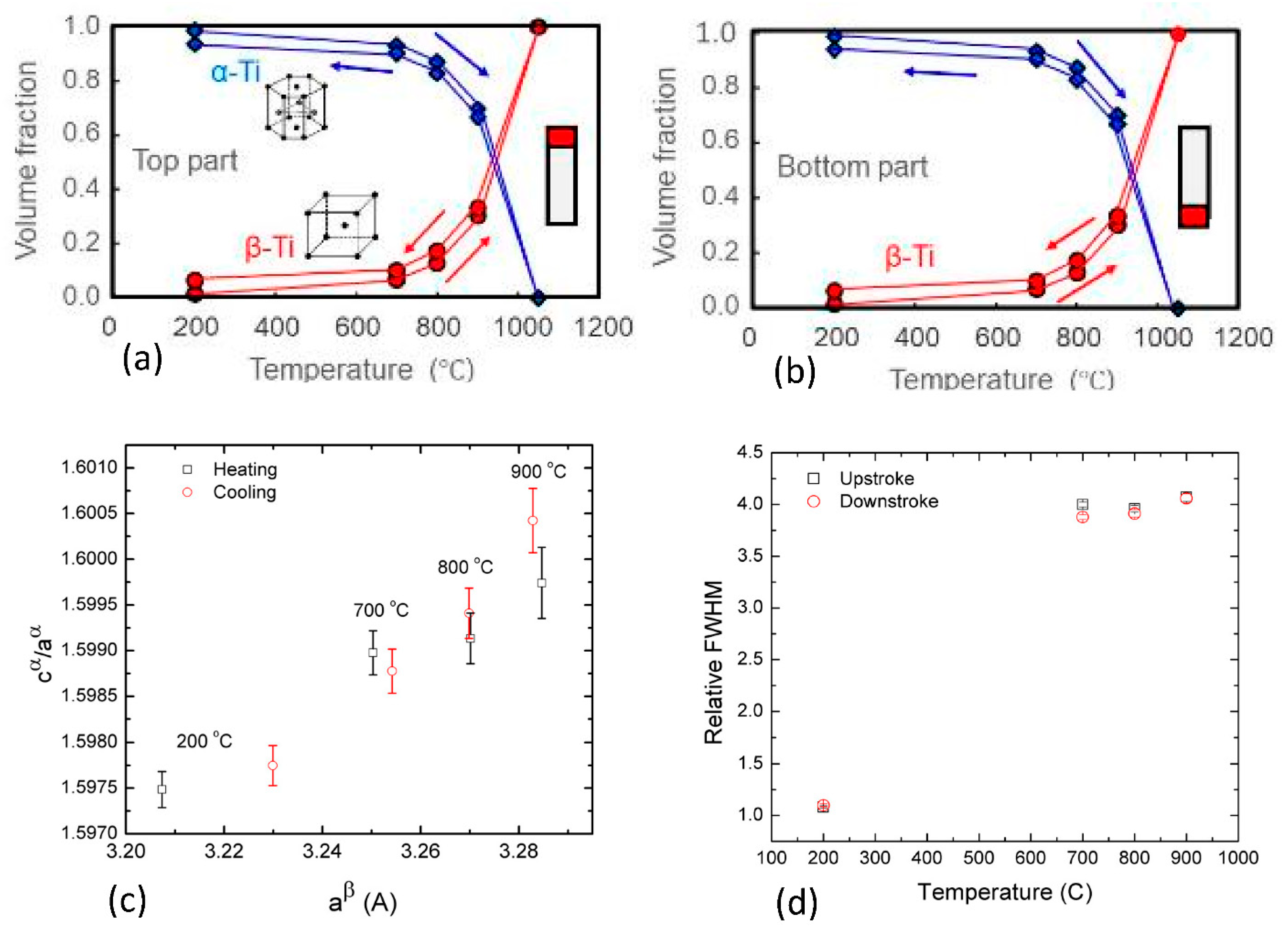

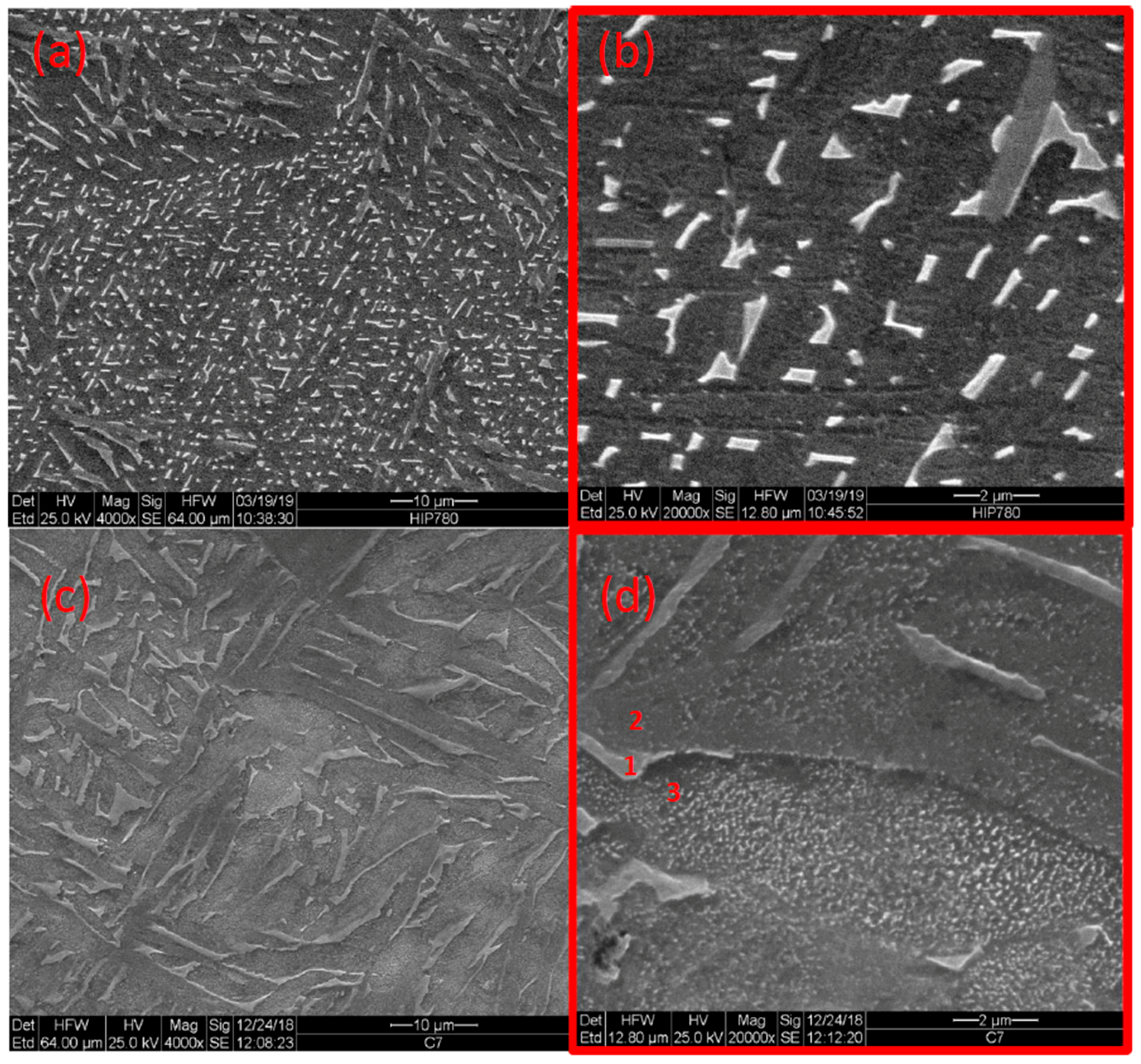
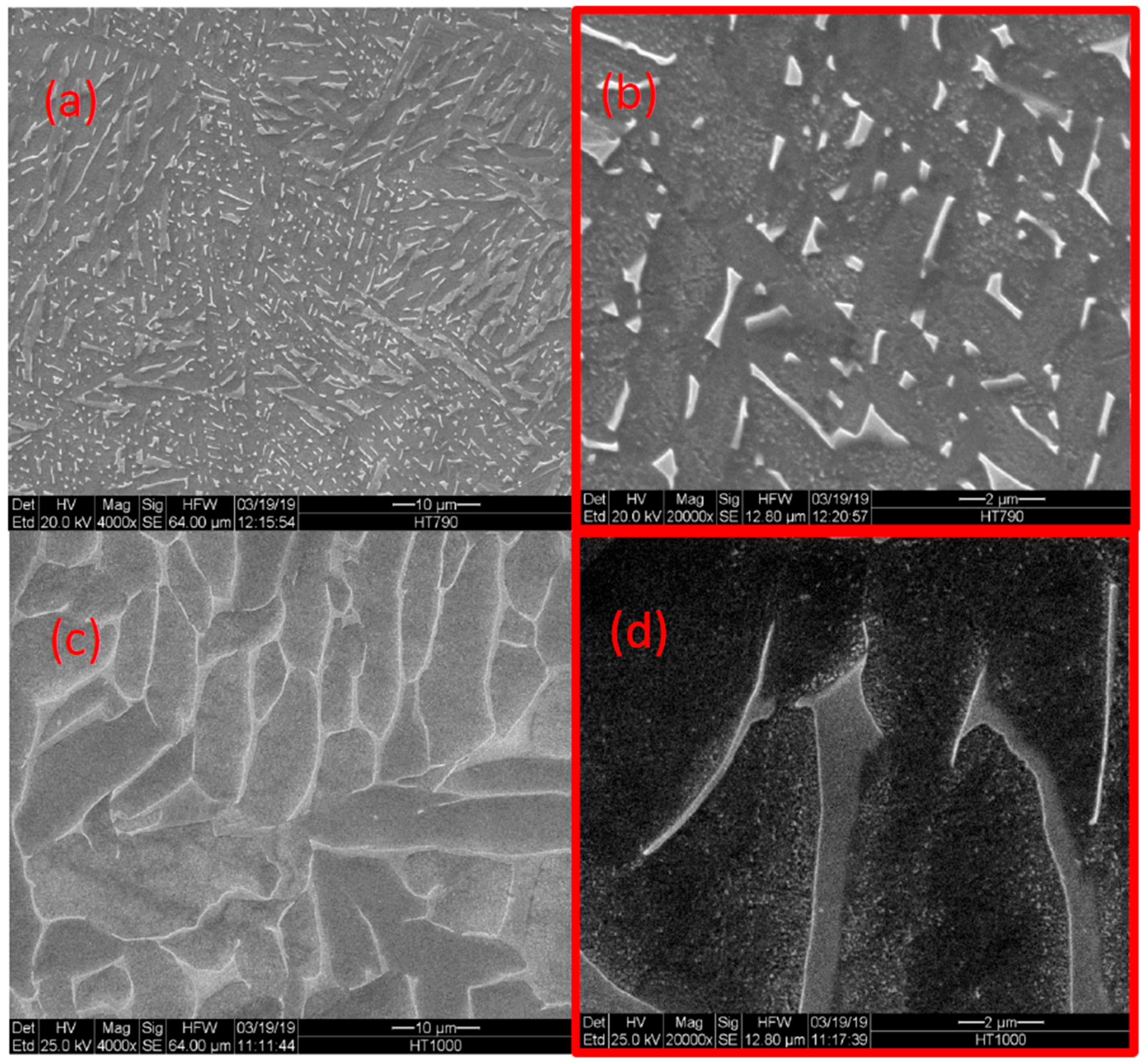


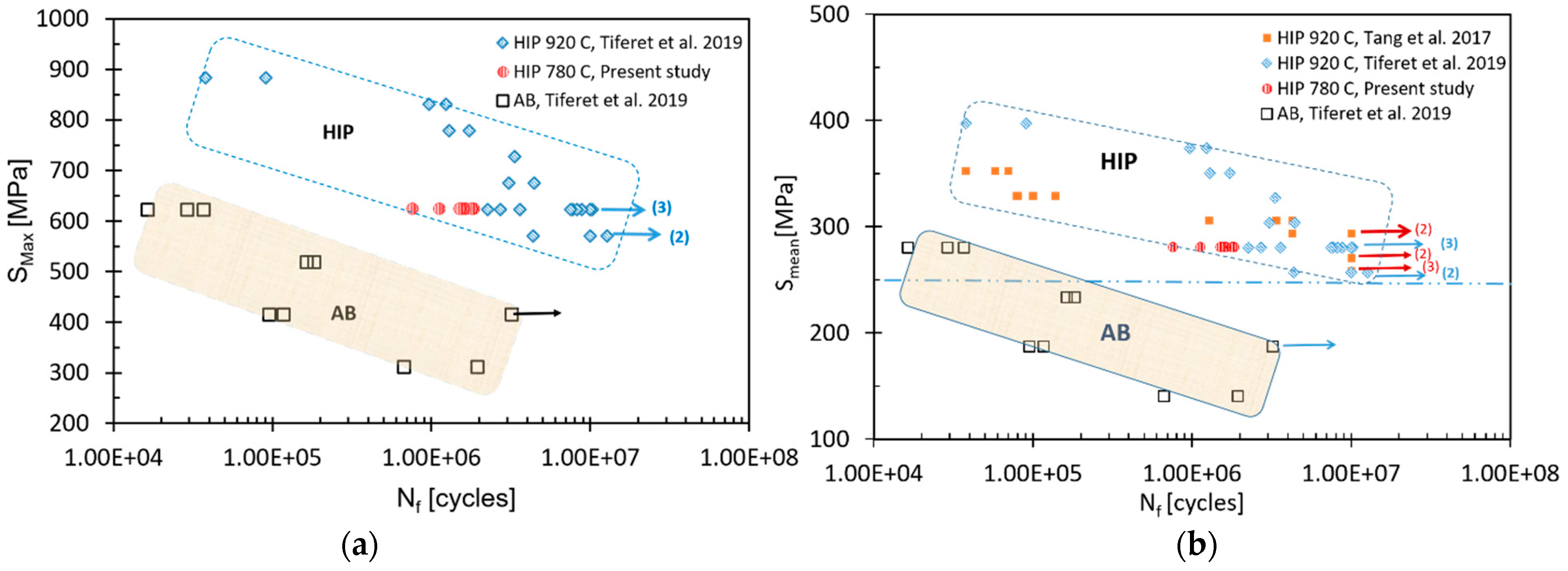



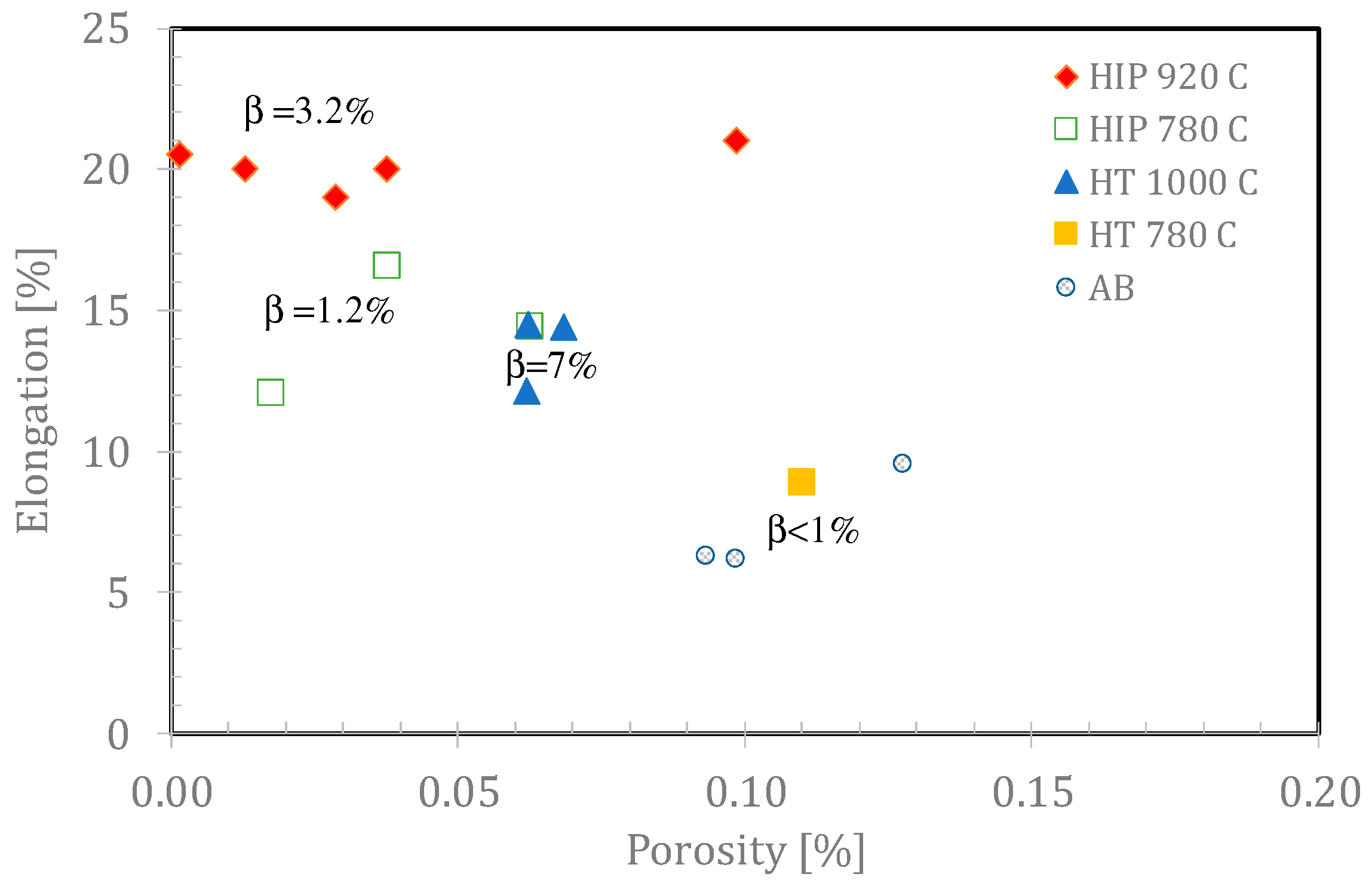
| No. | Group | Post Treatment |
|---|---|---|
| 1 | As-built | None |
| 2 | HIP-780 | HIP, 2h @ 780 °C under 120 MPa |
| 3 | HIP-920 | HIP, 2h @ 920 °C under 120 MPa |
| 4 | HT-780 | Vacuum heat treatment, 2 h @ 780 °C |
| 5 | HT-1000 | Vacuum heat treatment, 2 h @ 1000 °C |
| 6 | Commercial | Extruded and annealed 1/2″ rod |
| Metallurgical State | β Phase Content [%] | Relative Density [%] |
|---|---|---|
| As Built | <1 | 99.89 ± 0.03 |
| HIP 780 °C | 1.25 | 99.98 ± 0.02 |
| HIP 920 °C | 3.2 | 99.98 ± 0.04 |
| HT 1000 °C | 7 | 99.91 ± 0.01 |
| Measured Phase | Aluminum [wt %] | Vanadium [wt %] | Iron [wt %] | Titanium [wt %] |
|---|---|---|---|---|
| AB—Bright Phase (1) | 6.58 | 7.05 | 0.51 | 85.86 |
| AB—Dark Phase (2) | 6.04 | 5.26 | 0.27 | 88.44 |
| HIP 920 °C—Bright Phase (1) | 5.41 | 9.03 | 0.25 | 85.31 |
| HIP 920 °C—Dark Phase (2) | 6.60 | 3.25 | Not detected | 90.15 |
| HIP 920 °C—Mixed Phase (3) | 6.12 | 6.78 | Not detected | 87.10 |
| Group | E * [GPa] | YS [MPa] | UTS [MPa] | El. [%] | Ra | HV10N | Number of Samples |
|---|---|---|---|---|---|---|---|
| AB | 122.1 ± 1 | 1038 ± 7 | 1135 ± 4 | 7.3 ± 1.9 | 12 ± 5 | 372 ± 4 | 3 |
| HT-780 | 120.7 ± 1 | 1042 | 1133 | 8.9 | 12 | 372 ± 3 | 1 |
| HT-1000 | 118.0 ± 1 | 927 ± 7 | 1063 ± 8 | 13.7 ± 1.0 | 25 ± 5 | 338 ± 4 | 3 |
| HIP-780 | 118.0 ± 1 | 1035 ± 1 | 1129 ± 1 | 14.4 ± 2.3 | 28 ± 1 | 374 ± 5 | 3 |
| HIP-920 [4] | 118.5 ± 1 | 976 ± 19 | 1090 ± 18 | 20.1 ± 0.7 | 43 ± 2 | 358 ± 7 | 5 |
| Extruded rod-annealed | 108.0 ± 1 | 909, 917 | 1034, 1037 | 15.4, 16.8 | 50 ± 1 | 349 ± 3 | 2 |
| ASTM F136 Ti-6Al-4V Wrought | ≥795 min | ≥860 | ≥10 | ||||
| ASTM F2924 Tensile | ≥825 | ≥895 | ≥10 |
| Treatment | SMax [MPa] | Number of Samples | σmax/YS | σavg [MPa] | Number of Cycles, Nf |
|---|---|---|---|---|---|
| AB [4] | 623 | 3 | 0.60 | 343 | 2.7 ± 1.0 × 104 |
| HIP-780 | 624 | 8 | 0.60 | 343 | 1.5 ± 0.4 × 106 |
| HIP-920 [4] | 623 | 11 | 0.64 | 343 | 6.6 ± 3.2 × 106 |
| HIP-920 [17] | 625 | 3 | 0.75 | 331 | 8.1 ± 3.2 × 106 |
Publisher’s Note: MDPI stays neutral with regard to jurisdictional claims in published maps and institutional affiliations. |
© 2021 by the authors. Licensee MDPI, Basel, Switzerland. This article is an open access article distributed under the terms and conditions of the Creative Commons Attribution (CC BY) license (http://creativecommons.org/licenses/by/4.0/).
Share and Cite
Ganor, Y.I.; Tiferet, E.; Vogel, S.C.; Brown, D.W.; Chonin, M.; Pesach, A.; Hajaj, A.; Garkun, A.; Samuha, S.; Shneck, R.Z.; et al. Tailoring Microstructure and Mechanical Properties of Additively-Manufactured Ti6Al4V Using Post Processing. Materials 2021, 14, 658. https://doi.org/10.3390/ma14030658
Ganor YI, Tiferet E, Vogel SC, Brown DW, Chonin M, Pesach A, Hajaj A, Garkun A, Samuha S, Shneck RZ, et al. Tailoring Microstructure and Mechanical Properties of Additively-Manufactured Ti6Al4V Using Post Processing. Materials. 2021; 14(3):658. https://doi.org/10.3390/ma14030658
Chicago/Turabian StyleGanor, Yaron Itay, Eitan Tiferet, Sven C. Vogel, Donald W. Brown, Michael Chonin, Asaf Pesach, Amir Hajaj, Andrey Garkun, Shmuel Samuha, Roni Z. Shneck, and et al. 2021. "Tailoring Microstructure and Mechanical Properties of Additively-Manufactured Ti6Al4V Using Post Processing" Materials 14, no. 3: 658. https://doi.org/10.3390/ma14030658





